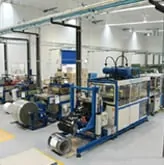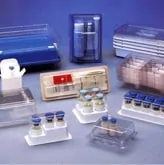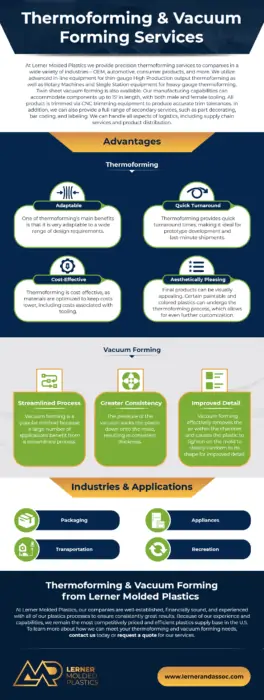(click on thumbnail to enlarge)


At Lerner Molded Plastics we provide precision thermoforming services to companies in a wide variety of industries – OEM, automotive, consumer products, and more. We utilize advanced in-line equipment for thin-gauge High Production output thermoforming as well as Rotary Machines and SIngle Station equipment for heavy-gauge thermoforming. Twin sheet vacuum forming is also available. Our manufacturing capabilities can accommodate components up to 15′ in length, with both male and female tooling. All product is trimmed via CNC trimming equipment to produce accurate trim tolerances. In addition, we can also provide a full range of secondary services, such as part decorating, bar coding, and labeling. We can handle all aspects of logistics, including supply chain services and product distribution.
For more information about our precision thermoforming services, or our other capabilities, please contact Lerner Molded Plastics.
Overview of Thermoforming and Vacuum Forming
Thermoforming and vacuum forming are both frequently used manufacturing methods for producing components. The thermoforming process entails heating thermoplastic sheets to a workable temperature. After heating, the thermoplastic is formed into the desired shape using a mold, and then excess material is trimmed to create the completed product.
Vacuum forming takes thermoforming one step further. In vacuum forming, the process applies vacuum pressure to more effectively mold the part. The vacuum pressure sucks the plastic down onto the mold to allow for consistent thickness and improved detail.
Uses and Advantages of Thermoforming
There are several key uses and advantages of thermoforming that make it one of the most popular processes across a wide range of applications.
Common Uses
Thermoforming is applicable to many uses. One of the most common applications is rigid packaging for consumer goods and food products. However, thermoforming is also used in many other types of applications because of its dependability and efficiency. Some other potential uses for thermoforming include everything from creating long-lasting surfaces on automobiles to manufacturing children’s toys.
Advantages
The thermoforming process comes with numerous advantages, including:
- Adaptable. One of thermoforming’s main benefits is that it is very adaptable to a wide range of design requirements.
- Quick turnaround. Thermoforming provides quick turnaround times, making it ideal for prototype development and last-minute shipments.
- Cost-effective. Thermoforming is cost-effective, as materials are optimized to keep costs lower, including costs associated with tooling.
- Aesthetically pleasing. Final products can be visually appealing. Certain paintable and colored plastics can undergo the thermoforming process, which allows for even further customization.
Why Vacuum Forming is a Popular Method
A large number of applications use vacuum forming in particular due to its streamlined process. Vacuum forming begins with the placement of a plastic sheet within vacuum forming machinery, which then heats and subsequently softens the plastic to make it more pliable. The system then places the heated sheet over a pre-made mold, which is often made with aluminum for durability and reusability. Once the plastic sheet comes into contact with the mold, the vacuum is activated, which applies suction to effectively remove the air within the chamber and cause the plastic to tighten on the mold to conform to its shape.
Once the plastic has cooled, engineers can use tooling equipment such as CNC machines to remove excess material. If needed, they can perform an additional pressure forming step, which uses positive air pressure to push the plastic deeper into the crevices of the mold for added detail.
Thermoformed Products
A wide variety of industries use thermoformed products, including the automotive, transport, aerospace, sports equipment, packaging, and medical industries. This process is also used for many other products featuring an industrial design.
Thermoformed parts manufacturers often want to produce high-quality products that are highly salable, with specific applications such as:
- Packaging
- Appliances
- Transportation
- Recreation
Many of these applications also rely on vacuum forming to create the completed product, along with other thermoforming processes depending on individual project specifications. Regardless of what’s needed for a given application, the thermoforming process is capable of meeting most requirements to optimize quality and efficiency.
Thermoforming and Vacuum Forming from Lerner Molded Plastics
At Lerner Molded Plastics, our companies are well-established, financially sound, and experienced with all of our plastics processes to ensure consistently great results. Because of our experience and capabilities, we remain the most competitively priced and efficient plastics supply base in the U.S. To learn more about how we can meet your thermoforming and vacuum forming needs, contact us today or request a quote for our services.
Portfolio
Custom Thermoforming Capabilities
| General Precision Thermoforming Capabilities |
|
||
| Molding Process |
|
||
| Draw | Male Female |
||
| Equipment Capabilities | CNC Trimming In-Gauge to Heavy Gauge |
||
| Material |
|
||
| Length | Up to 15 ft. | ||
| Draw Depth | Up to 3 Feet | ||
| Secondary Services | In-Line or Post Molded Secondary Assembly Ultrasonic Welding Part Decorating (Hot Stamping, Pad Printing, Painting) Bar Coding and Labeling Complete Packout Services Warehousing Services and Drop Ship Capability All Material, Packaging, and Components Sourcing Complete Supply Chain Services Product Distribution Logistics Engineering Product Development Mold Making Tooling Vendor Managed Inventory Programs Kanban |
||
| Production Volume | Prototype Runs to Full Production Capacity |
Additional Information
| Industry Focus |
|
||
| Intended Application |
|
||
| Industry Standards | ISO Certified UL Molder Certified |
||
| File Formats | SolidWorks Pro-Engineer |


